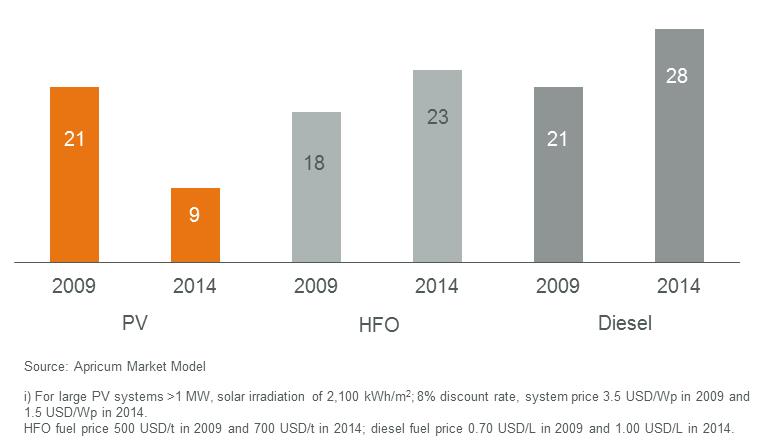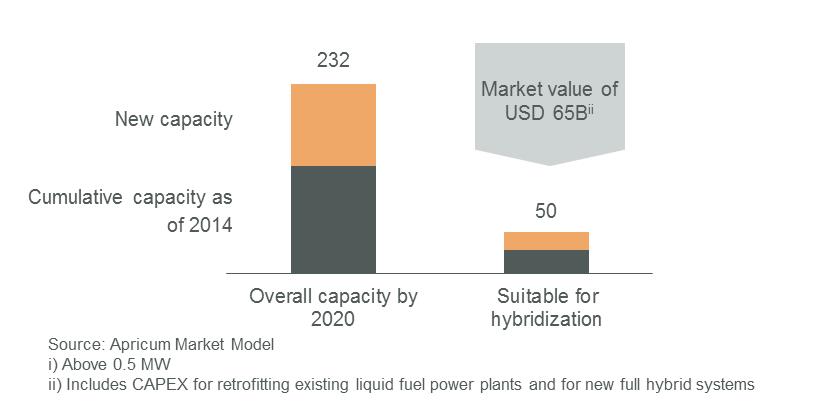Many regions in the world today cannot be sufficiently supplied by large, central power plants and therefore depend on distributed power generation. For many years, this market has been mainly served by fossil fuel-powered gensets. Renewable energy has increasingly become an economically attractive alternative thanks to falling system costs, but the intermittency of wind and solar power remains a major barrier. Hybrid renewable systems, however, combine the advantages of both technologies and therefore have the potential to unlock a vast and largely untapped market for wind and solar power.
Apricum Principal Florian Mayr examines the benefits and market potential of hybrid renewable solutions and the resulting opportunities and challenges for renewable energy project developers, turnkey providers of fossil fuel power plants and off-takers such as mines and cement factories.
Increasing competitiveness of renewable energy over liquid fossil fuels
Heavy fuel oil (HFO) or diesel-based power generation has been widely applied around the world. For capacities above 0.5 MW alone, there is a large global installed base of more than 132 GW, with the overall market growing by >15 GW annually.
Power generation based on liquid fossil fuels, however, has become less and less favorable for different reasons:
- Highly volatile and generally increasing fuel prices in most parts of the world
- Particularly high transport costs of fuels to remote sites that also bear a certain supply risk (e.g., Siberia, islands)
- Increasing dependence on energy imports and supply bottlenecks due to depleting domestic natural resources (e.g., in North Africa)
- Limited refining capacities for liquid fossil fuels (e.g., for diesel in Saudi Arabia)
In contrast, sunshine and wind do not depend on supply from external parties. Additionally, recent reductions in generation costs for PV and wind power have significantly increased the attractiveness of renewables. As can be seen in Figure 1 below, the PV system price for large systems has more than halved from greater than 3.5 to 1.5 USD/Wp in the last five years alone, resulting in LCOE as low as 9¢ USD/kWh in locations with good solar irradiance. Wind turbines in good wind areas can generate energy at competitive costs of 6–8¢ USD/kWh. Consequently, renewable energy is increasingly considered as a strong alternative by off-takers currently relying on diesel or HFO-based power generation.
Figure 1: LCOE development for PVi, HFO and diesel [¢ USD/kWh]

Overcoming the issue of intermittency can unlock vast untapped markets for renewables
The typical applications of diesel and HFO gensets are defining the potential markets for renewables. Mainly off-takers use liquid fuel-based plants to compensate inadequate power supply from centralized generation, e.g.,
- At off-grid sites and in mini-grids that are not connected to any large grid due to their remote location, requiring captive/distributed power generation to meet demand (e.g., mining sites, islands)
- In weak grids which continuously[1] fail to provide the required amount of power due to insufficient generation or transmission capacities, hence creating the need for additional captive power generation (e.g., in many West African countries).
For these applications, however, the intermittent character of wind and solar power imposes a significant entry barrier to renewable energy. Load profiles of off-takers often do not match renewable power availability, for example, during the night. Also, many off-takers such as mining sites require a constant and high power quality due to security reasons and critical processes. Furthermore, in contrast to applications in large and stable grids, it is typically not possible to compensate for fluctuations in renewable energy by dispatching other flexible power plants.
Only solutions that deal with the intermittency issue at a plant level can unlock the vast market currently served by liquid fossil fuels for renewable energy.
[1] Diesel and HFO gensets used as backup capacities for irregular blackouts is obviously another major application, but not suitable for hybridization
Hybrid renewable solutions: Potential to unlock a USD 65B market by 2020
Hybrid renewable solutions have the potential to economically solve the intermittency issue and ensure an uninterrupted and high quality power supply by combining liquid fossil fuel-based generation with PV or wind power directly at the site.
Simplified, a hybrid renewable system comprises both fossil fuel and renewable-based generation units which are complemented by integrating components such as power control units, converters and, in some cases, storage.
The concept is quite straight forward: Whenever the sun is shining or the wind is blowing, renewable power is provided from PV modules or wind turbines at maximum fuel savings. If renewable power is only partially available (e.g., due to clouds) or not available at all (e.g., no wind), the fossil fuel engines can compensate for intermittency or even provide full power.
The penetration of renewable energy in hybrid systems and therefore the benefit of hybridization mainly depend on the renewable resources at the specific site and the load profile of the target application. For example, a standard PV hybrid system set up in an area with high solar irradiation (≥2000 kWh/m2) and 24/7 stable load allows for a PV share of 15% as the fossil engine has to run at 40% to provide sufficient ramp-up times at adequate economics. Higher PV shares can be reached, for example, through oversizing of the PV capacities or through adding storage units such as batteries. Even with the additional investment required, these solutions may still be the most attractive economically due to larger fuel savings.
Various customer groups have already started meeting their power generation needs with hybrid renewable solutions. For example, at one of their South African mining sites, Cronimet hybridized their diesel generators in 2012 at an off-grid location with 1 MW of photovoltaic standard modules to reduce their diesel consumption by 30%. Other examples exist for textile mills, cement plants or supermarkets.
Apricum estimates the global market potential for PV hybrid and wind hybrid solutions to be USD 65B by 2020. This figure is based on the capex for retrofitting existing fossil fuel plants as well as setting up greenfield hybrid plants with diesel or HFO gensets in suitable locations, e.g., sites that have high fuel costs and sufficient renewable resources.
Figure 2: Global installed base of HFO and diesel enginesi used for continuous power generation by 2020 [GW]

Implications for key stakeholders
The increasing attractiveness of hybrid renewable solutions has different implications for the three key stakeholder groups:
- Renewable energy project developers
- Turnkey fossil fuel power plant providers
- Power off-takers
From the individual perspective of each stakeholder group, specific market opportunities can be realized, but challenges must also be considered.
Renewable energy project developers
- Situation: Stagnating demand in established markets such as Europe and intense competition in new markets result in lower margins for downstream renewable players, creating the need to differentiate from competition with new business models
- Opportunity: Unlock new markets for renewables and differentiate from competition by retrofitting existing liquid fuel power generation with renewables or setting up new hybrid solutions at greenfield sites
- Key challenges: Understanding specific customer requirements and concerns, offering the right value proposition (e.g., through customized PPA structures and system setups) and building up necessary new capabilities
Turnkey fossil fuel power plant providers
- Situation: Traditional customers of turnkey power plant providers such as utilities and mines increasingly ask for hybrid renewable solutions to reduce their fossil fuel exposure. Consequently, the market share of providers of “pure” fossil fuel-powered generation systems is expected to decrease
- Opportunity: Turnkey providers should proactively address the rising competition by offering hybrid renewable solutions themselves, especially as they already have good access to customer groups and can leverage cross-selling potential
- Key challenges: Likewise for renewable energy project developers, specific business models and additional technical capabilities are required to succeed in the new business
Power off-takers
- Situation: Hybrid renewable systems offer new possibilities to use renewable power at sites with inadequate power supply to decrease fossil fuel exposure
- Opportunity: Hybrid solutions can help to decrease the overall energy costs, mitigate the effect of fuel price volatility and diminish the dependence on external fuel supply
- Key challenges: Key issues need to be addressed for realizing hybrid solutions, including the technical and economic feasibility of projects, the optimal commercial model and a suitable implementation strategy
Apricum’s hybrid renewable energy services
Apricum offers tailored support for each of the above stakeholder groups to help them benefit from the new opportunities presented by the hybrid renewable market. Both for players providing solutions in renewable and fossil energy, we help to assess and prioritize technologies, geographies and customer segments, develop suitable business models and support the initiation of business development activities through partnerships and pilot projects. For off-takers, we evaluate the individual technical and commercial feasibility, set up the right commercial model and select the best provider for the hybrid renewable solution.
For questions or comments, please contact Florian Mayr, principal: mayr@apricum-group.com

